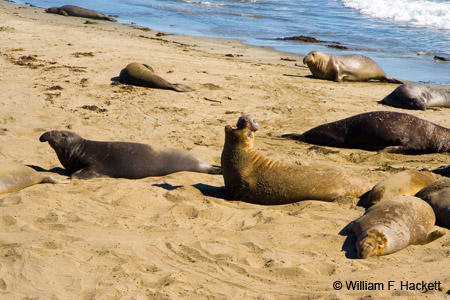Elephant Seals

One of the very fascinating (and very LARGE) animals that inhabit the California coast is the Northern Elephant Seal. The elephant seals (1, 2, 3, 4, 5, 6) derive their name from their great size and the large probosis of the male, which is used in making loud roaring noises (pictured above, in July, at the rookery near the Piedras Blancas Lighthouse (1) north of San Simeon [home to Hearst Castle] on Highway 1). Another place to see elephant seals is at Año Nuevo State Reserve, a few miles north of Santa Cruz and 55 miles (90 km) south of San Francisco. Currently, the San Simeon site hosts more breeding animals than the Año Nuevo site during the winter, according to Wikipedia.
There is great sexual dimorphism in elephant seals. The males (bulls) can reach 5 m (I said very LARGE!  ) in length and average 1800 kg (4000 lbs). The females (cows) average about 3 m in length and 650 kg (1400 lbs). There is a polygynous mating system, with one successful bull able to impregnate up to 50 cows of his harem in one mating season. Bulls engage in dramatic fights for supremacy over other males in the struggle to mate. The fights are not usually to the death, but can involve bloodshed. Most males will never mate, but a successful bull can sire over 500 pups. Unsuccessful males often retreat to the dunes or to “bachelor beaches” nearby that harbor males practicing their combat skills for next time.
) in length and average 1800 kg (4000 lbs). The females (cows) average about 3 m in length and 650 kg (1400 lbs). There is a polygynous mating system, with one successful bull able to impregnate up to 50 cows of his harem in one mating season. Bulls engage in dramatic fights for supremacy over other males in the struggle to mate. The fights are not usually to the death, but can involve bloodshed. Most males will never mate, but a successful bull can sire over 500 pups. Unsuccessful males often retreat to the dunes or to “bachelor beaches” nearby that harbor males practicing their combat skills for next time.
Although elephant seals do not attack humans per se, bulls (remember, they can be 2 tons!) can move faster than a human can run and will attack rival males without heeding anything (or anyone!) in between.
Elephant seals were hunted almost to extinction (for their blubber) by the end of the 19th century. Since the early 20th century, elephant seals have been protected by law in both Mexico and the United States. The population of elephant seals in the U.S. is now over 100,000 since the passage of the Marine Mammal Protection Act. The good news is that populations of rookery sites in California have exploded in the last 50 years. Thousands of pups are born each year at Ano Nuevo (island and mainland) and the growth of the site at San Simeon, where there were no animals at all prior to 1990, has been even more spectacular.
We were surprised one year to find cars pulled over north of San Simeon with people looking at elephant seals where none had been before! In later years, a parking lot and information on the elephant seal life cycle appeared. If you visit Hearst Castle or Big Sur (1, 2), you may want to remember how close the rookery at Piedras Blancas (San Simeon) really is!
-Bill at Cheshire Cat Photo™
You can view higher-resolution photos (*generally* 7-30 megabytes, compressed) at the Cheshire Cat Photo™ Pro Gallery on Shutterfly™, where you can also order prints and gifts decorated with the photos of your choice from the gallery. Apparel and other gifts decorated with some of our most popular photos can be ordered from the Cheshire Cat Photo™ Store on CafePress®.







